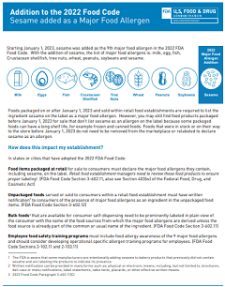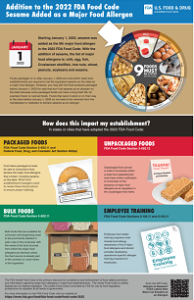Addition to the 2022 Food Code - Sesame added as a Major Food Allergen
Starting January 1, 2023, sesame was added as the 9th major food allergen in the 2022 FDA Food Code. With the addition of sesame, the list of major food allergens is: milk, egg, fish, Crustacean shellfish, tree nuts, wheat, peanuts, soybeans and sesame.
Foods packaged on or after January 1, 2023 and sold within retail food establishments are required to list the ingredient sesame on the label as a major food allergen. However, you may still find food products packaged before January 1, 2023 for sale that don’t list sesame as an allergen on the label because some packaged foods can have a long shelf life, for example frozen and canned foods. Foods that were in stock or on their way to the store before January 1, 2023 do not need to be removed from the marketplace or relabeled to declare sesame as an allergen.
How does this impact my establishment?
In states or cities that have adopted the 2022 FDA Food Code:
Food items packaged at retail for sale to consumers must declare the major food allergens they contain, including sesame, on the label. Retail food establishment managers need to review these food products to ensure proper labeling[1]. (FDA Food Code Section 3-602.11, also see Section 403(w) of the Federal Food, Drug, and Cosmetic Act)
Unpackaged foods served or sold to consumers within a retail food establishment must have written notification[2] to consumers of the presence of major food allergens as an ingredient in the unpackaged food items. (FDA Food Code Section 3-602.12)
Bulk foods[3] that are available for consumer self-dispensing need to be prominently labeled in plain view of the consumer with the name of the food sources from which the major food allergens are derived unless the food source is already part of the common or usual name of the ingredient. (FDA Food Code Section 3-602.11)
Employee food safety training programs must include food allergy awareness of the 9 major food allergens and should consider developing operational specific allergen training programs for employees. (FDA Food Code Sections 2-102.11 and 2-103.11).
Resources
The FDA model Food Code is the primary resource for compliance and enforcement of food safety provisions and information regarding major food allergens in retail food establishments. The model Food Code is neither federal law nor federal regulation. The model Food Code is provided by FDA for use by food regulatory jurisdictions for adoption at all levels of government. Below is a list of specific parts in the Food Code and its annexes to assist regulatory authorities in this effort to manage major food allergens at retail. The annexes are provided specifically to assist the regulatory authority to apply the provisions of the Food Code uniformly and effectively. These resources can provide tremendous assistance to those charged with applying Food Code provisions.
Part 1-2 Definitions, “Major Food Allergen”
Section 2-102.11 Demonstration
Section 2-103.11 Person in Charge
Section 3-602.11 Food Labels
Section 3-602.12 Other Forms of Information
Food Code Annex 3, Public Health Reasons / Administrative Guidelines
For more information visit Allergic to Sesame? Food Labels Now Must List Sesame as an Allergen.
[1] The FDA is aware that some manufacturers are intentionally adding sesame to bakery products that previously did not contain sesame and are labeling the products to indicate its presence.
[2] Written notification can be provided in many forms such as: physical or electronic means, including, but not limited to, brochures, deli case or menu notifications, label statements, table tents, placards, or other effective written means.
[3] 2022 Food Code Paragraph 3-602.11(C)


